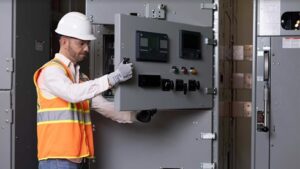
In a recent blog on mitigating arc flash events, we discussed the importance of integrating safety into electrical design. As an electrical contractor, you and your employees are on the front lines of this integration. All of the work and resources that go into designing systems, specifying the right equipment, and developing electrical safety programs are tested every time you interact with electrical equipment. In your industry, safety by design is more than a concept or strategy. It has real-time implications with a direct impact on worker safety and the work environment, both for your staff and your customers.
There are two primary hazards associated with electrical equipment — shock and arc flash. Shock is most common. It happens when direct contact with energized components causes electrical current to pass through the body. Many of us have received mild shocks in our lifetime, but when current in excess of 6 milliamperes flows through the body, the effects can be serious or even fatal.
An arc flash has the potential to cause serious injuries and catastrophic damage to equipment and facilities. Though they occur less frequently than shock, the human and economic toll of an arc flash incident is often considerably higher.
The safe work practice standards established in National Fire Protection Association (NFPA 70E®) is your roadmap for reducing and eliminating the risk of shock and arc flash. NFPA 70E requires workers to perform a risk assessment and implement controls to reduce the risk. Engineering controls, which are at the center of a safety-by-design approach, are very effective risk-reduction methods. These controls include equipment designed specifically to avoid, prevent, reduce, and isolate electrical hazards. ArcBlok 2500™ by Schneider Electric™ is the latest innovation that accomplishes all four of these outcomes.
How ArcBlok prevents arc flashes
ArcBlok 2500 is a passive, arc flash-prevention solution that is compatible with low-voltage switchboards and motor control centers up to 2,500 amperes. It requires no power, is always on, and is certified to extinguish and contain up to five arcing faults before replacement is necessary. Even if a line-side arcing fault occurs, there is no breaker trip, no unplanned downtime, and no catastrophic equipment damage. Instead of a crisis that disrupts your client’s business, the power stays on and operations continue normally until you can perform maintenance.
ArcBlok works by isolating the line-side connectors in a rugged ANSI/IEEE C37.20.7-2017-rated cable vault. Inside, barriers between the phases elongate and clear arcing faults in 16.66 milliseconds, which is less than one cycle. The resulting arc flash incident energy (AFIE) outside the vault is limited to no more than 1.2 cal/cm2. The risk of electrical shock is also eliminated because the vault prevents accidental touches, tools, or debris from contacting the energized line-side conductors.
Safety and workflow benefits for contractors
As you’re probably aware, de-energizing equipment is a critical step in the lockout/tagout (LOTO) procedure as specified in NFPA 70E. Until recently, however, de-energizing on the line-side required either a call for a utility outage or the installation of a disconnecting means between the utility and the point of work.
Remotely locating the disconnect allows downstream equipment to be de-energized. But this adds complexity and expense to the system; it’s an imperfect design since working on the remote disconnect still requires a utility outage. ArcBlok enables the main disconnect to serve as a lockout point that eliminates exposure to the shock and arc flash hazards that would otherwise exist on the line-side of the main.
As noted above, ArcBlok reduces line side AFIE to 1.2 cal/cm2 at a working distance of 18 in. It is an important number since it establishes the arc flash boundary. By staying below this level, workers are outside the arc flash boundary and don’t need to utilize arc-rated personal protective equipment (PPE).
In some systems where fault clearing takes a relatively long time, AFIE levels can far exceed the ratings on commercially available PPE. Typical solutions include remote operation methods that increase the distance between workers and the equipment to lower the exposure level. Even when PPE is available, energized work on equipment with elevated AFIE levels often results in the need for PPE that is hot and reduces worker dexterity. ArcBlok offers a new solution to control the risks associated with the line-side shock and arc flash hazards and can significantly lower the AFIE levels for electrical workers.
ArcBlok is also configured for continuous thermal monitoring (CTM) and can be specified with an integrated absence of voltage tester. CTM removes the need for interval-based infrared thermography of the line side connections, which means fewer interactions with energized equipment, less equipment, and reduced system complexity. The data provided by CTM also provides the opportunity to add value for customers by offering preventative maintenance aimed at improving system performance and reducing downtime.
Safety and compliance considerations
It’s important to note that ArcBlok is strictly for line-side arc flash and shock prevention. Of course, when the main is on, arc flash and shock hazards still exist on the load side if the main device is closed — for example, during some maintenance and testing activities. Load-side AFIE is likely to be less than what is present on the line side, but an engineering arc flash study must be performed to determine what risk controls are necessary.
When it comes to compliance, ArcBlok checks the right boxes for electrical safety design. It is one of the incident-energy-reduction methods outlined in Annex 0.2.3 of NFPA 70E and it effectively reduces line-side AFIE at a challenging location — the service to a facility.
ArcBlok is an innovative, effective, compliant solution for avoiding, preventing, reducing, and isolating arc flashes and related electrical hazards. It’s your ally for increasing efficiency and productivity when you or your staff are working on electrical equipment, as well as a value-add for potential customers seeking the same workflow benefits throughout the lifecycle of the equipment.
Download our safety-by-design white paper to learn more about how engineering controls can reduce arc flash risks.


